engine FIAT STILO 2006 1.G Service Manual
[x] Cancel search | Manufacturer: FIAT, Model Year: 2006, Model line: STILO, Model: FIAT STILO 2006 1.GPages: 274, PDF Size: 4.76 MB
Page 148 of 274
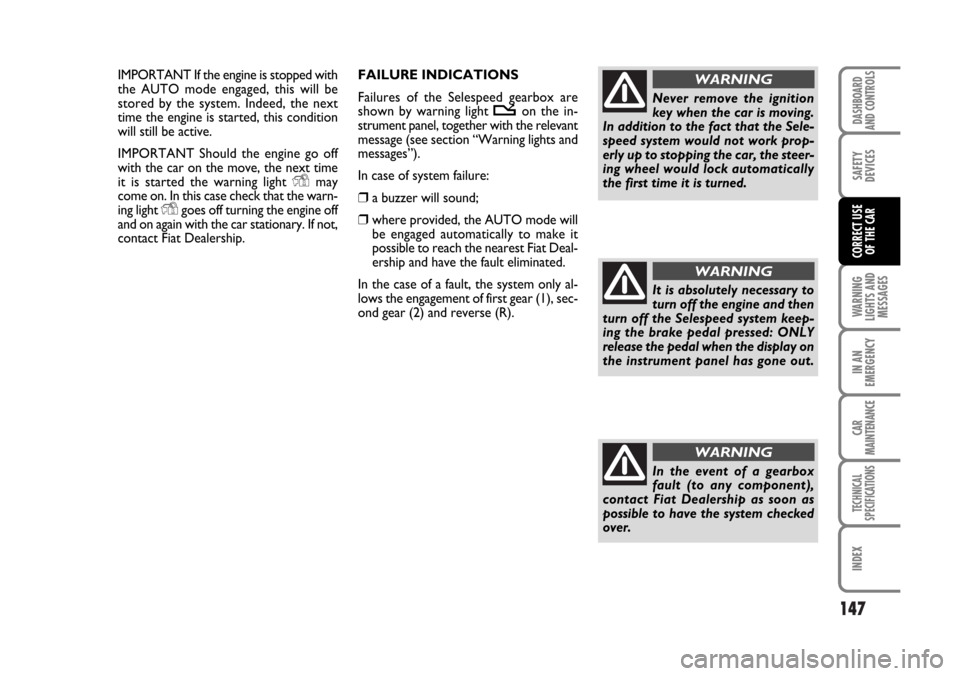
147
WARNING
LIGHTS AND
MESSAGES
IN AN
EMERGENCY
CAR
MAINTENANCE
TECHNICAL
SPECIFICATIONS
INDEX
DASHBOARD
AND CONTROLS
SAFETY
DEVICES
CORRECT USE
OF THE CAR
FAILURE INDICATIONS
Failures of the Selespeed gearbox are
shown by warning light
ton the in-
strument panel, together with the relevant
message (see section “Warning lights and
messages”).
In case of system failure:
❒a buzzer will sound;
❒where provided, the AUTO mode will
be engaged automatically to make it
possible to reach the nearest Fiat Deal-
ership and have the fault eliminated.
In the case of a fault, the system only al-
lows the engagement of first gear (1), sec-
ond gear (2) and reverse (R). IMPORTANT If the engine is stopped with
the AUTO mode engaged, this will be
stored by the system. Indeed, the next
time the engine is started, this condition
will still be active.
IMPORTANT Should the engine go off
with the car on the move, the next time
it is started the warning light
Ymay
come on. In this case check that the warn-
ing light
Ygoes off turning the engine off
and on again with the car stationary. If not,
contact Fiat Dealership.
Never remove the ignition
key when the car is moving.
In addition to the fact that the Sele-
speed system would not work prop-
erly up to stopping the car, the steer-
ing wheel would lock automatically
the first time it is turned.
WARNING
It is absolutely necessary to
turn off the engine and then
turn off the Selespeed system keep-
ing the brake pedal pressed: ONLY
release the pedal when the display on
the instrument panel has gone out.
WARNING
In the event of a gearbox
fault (to any component),
contact Fiat Dealership as soon as
possible to have the system checked
over.
WARNING
Page 149 of 274
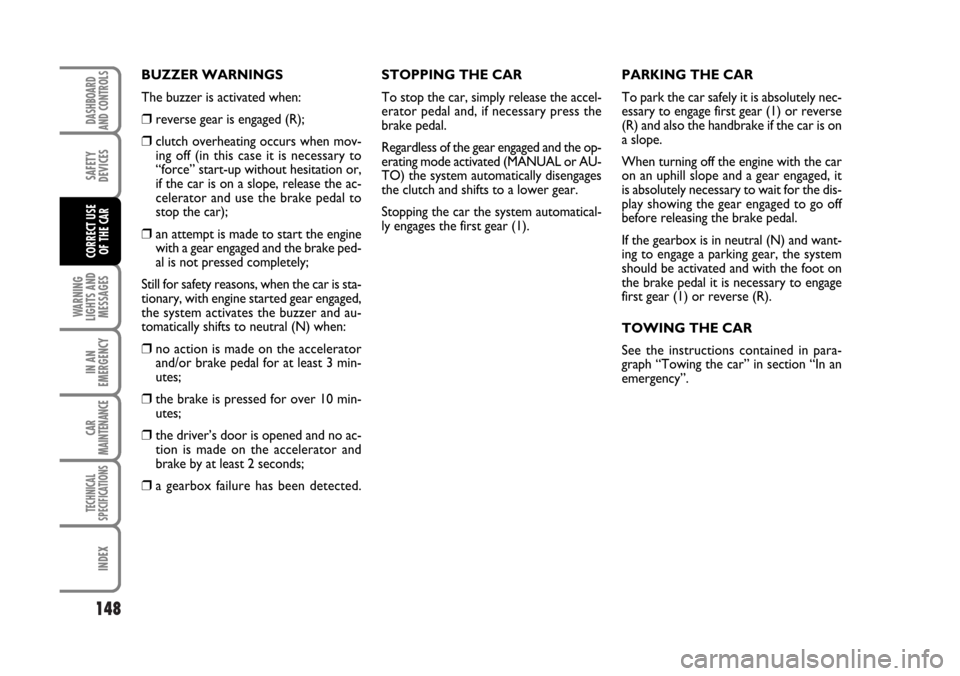
148
WARNING
LIGHTS AND
MESSAGES
IN AN
EMERGENCY
CAR
MAINTENANCE
TECHNICAL
SPECIFICATIONS
INDEX
DASHBOARD
AND CONTROLS
SAFETY
DEVICES
CORRECT USE
OF THE CAR
STOPPING THE CAR
To stop the car, simply release the accel-
erator pedal and, if necessary press the
brake pedal.
Regardless of the gear engaged and the op-
erating mode activated (MANUAL or AU-
TO) the system automatically disengages
the clutch and shifts to a lower gear.
Stopping the car the system automatical-
ly engages the first gear (1).PARKING THE CAR
To park the car safely it is absolutely nec-
essary to engage first gear (1) or reverse
(R) and also the handbrake if the car is on
a slope.
When turning off the engine with the car
on an uphill slope and a gear engaged, it
is absolutely necessary to wait for the dis-
play showing the gear engaged to go off
before releasing the brake pedal.
If the gearbox is in neutral (N) and want-
ing to engage a parking gear, the system
should be activated and with the foot on
the brake pedal it is necessary to engage
first gear (1) or reverse (R).
TOWING THE CAR
See the instructions contained in para-
graph “Towing the car” in section “In an
emergency”. BUZZER WARNINGS
The buzzer is activated when:
❒reverse gear is engaged (R);
❒clutch overheating occurs when mov-
ing off (in this case it is necessary to
“force” start-up without hesitation or,
if the car is on a slope, release the ac-
celerator and use the brake pedal to
stop the car);
❒an attempt is made to start the engine
with a gear engaged and the brake ped-
al is not pressed completely;
Still for safety reasons, when the car is sta-
tionary, with engine started gear engaged,
the system activates the buzzer and au-
tomatically shifts to neutral (N) when:
❒no action is made on the accelerator
and/or brake pedal for at least 3 min-
utes;
❒the brake is pressed for over 10 min-
utes;
❒the driver’s door is opened and no ac-
tion is made on the accelerator and
brake by at least 2 seconds;
❒a gearbox failure has been detected.
Page 150 of 274

149
WARNING
LIGHTS AND
MESSAGES
IN AN
EMERGENCY
CAR
MAINTENANCE
TECHNICAL
SPECIFICATIONS
INDEX
DASHBOARD
AND CONTROLS
SAFETY
DEVICES
CORRECT USE
OF THE CAR
CONTAINING
RUNNING COSTS
Here are some suggestions which may
help you to keep the running costs of your
car down and lower the amount of toxic
emissions released into the atmosphere.
GENERAL CONSIDERATIONS
Car maintenance
Have checks and adjustments carried out
in accordance with the “Service schedule”.
Tyres
Check the pressure of the tyres routine-
ly at an interval of no more than 4 weeks:
if the pressure is too low, consumption
levels increase as resistance to rolling is
higher.
Unnecessary loads
Do not travel with too much luggage
stowed in the boot. The weight of the car
(especially when driving in town) and its
trim greatly affects consumption and sta-
bility.Roof rack/ski rack
Remove the roof rack or the ski rack from
the roof as soon as they are no longer
used. These accessories lower air pene-
tration and adversely affect consumption
levels. When needing to carry particular-
ly voluminous objects, preferably use a
trailer.
Electric devices
Use electric devices only for the amount
of time needed. Rear heated window, ad-
ditional headlights, windscreen wipers and
heater fan need a considerable amount of
energy, therefore increasing the require-
ment of current increases fuel consump-
tion (up to +25% in the urban cycle).Climate control
The air conditioner is an additional load
which greatly affects the engine leading to
higher consumption (on average up to
+20%). When the temperature outside
the car permits it, use the air vents where
possible.
Spoilers
The use of non-certified aerodynamic
items may adversely affect air drag and
consumption levels.
Page 151 of 274
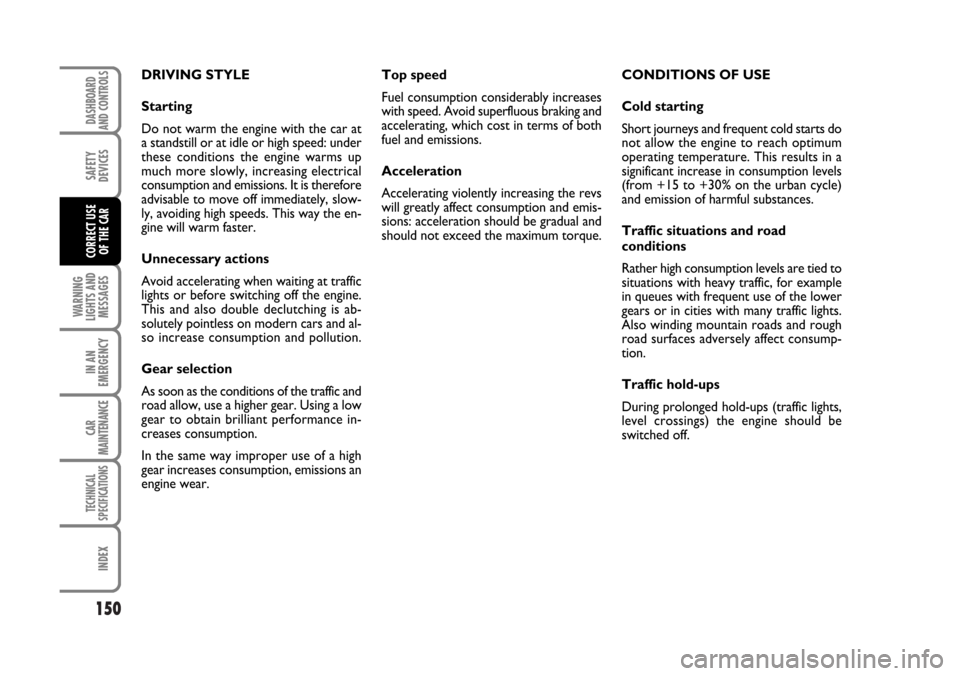
150
WARNING
LIGHTS AND
MESSAGES
IN AN
EMERGENCY
CAR
MAINTENANCE
TECHNICAL
SPECIFICATIONS
INDEX
DASHBOARD
AND CONTROLS
SAFETY
DEVICES
CORRECT USE
OF THE CAR
Top speed
Fuel consumption considerably increases
with speed. Avoid superfluous braking and
accelerating, which cost in terms of both
fuel and emissions.
Acceleration
Accelerating violently increasing the revs
will greatly affect consumption and emis-
sions: acceleration should be gradual and
should not exceed the maximum torque.CONDITIONS OF USE
Cold starting
Short journeys and frequent cold starts do
not allow the engine to reach optimum
operating temperature. This results in a
significant increase in consumption levels
(from +15 to +30% on the urban cycle)
and emission of harmful substances.
Traffic situations and road
conditions
Rather high consumption levels are tied to
situations with heavy traffic, for example
in queues with frequent use of the lower
gears or in cities with many traffic lights.
Also winding mountain roads and rough
road surfaces adversely affect consump-
tion.
Traffic hold-ups
During prolonged hold-ups (traffic lights,
level crossings) the engine should be
switched off. DRIVING STYLE
Starting
Do not warm the engine with the car at
a standstill or at idle or high speed: under
these conditions the engine warms up
much more slowly, increasing electrical
consumption and emissions. It is therefore
advisable to move off immediately, slow-
ly, avoiding high speeds. This way the en-
gine will warm faster.
Unnecessary actions
Avoid accelerating when waiting at traffic
lights or before switching off the engine.
This and also double declutching is ab-
solutely pointless on modern cars and al-
so increase consumption and pollution.
Gear selection
As soon as the conditions of the traffic and
road allow, use a higher gear. Using a low
gear to obtain brilliant performance in-
creases consumption.
In the same way improper use of a high
gear increases consumption, emissions an
engine wear.
Page 153 of 274

152
WARNING
LIGHTS AND
MESSAGES
IN AN
EMERGENCY
CAR
MAINTENANCE
TECHNICAL
SPECIFICATIONS
INDEX
DASHBOARD
AND CONTROLS
SAFETY
DEVICES
CORRECT USE
OF THE CAR
The towing device must meet current reg-
ulations with reference to 94/20/EC Di-
rective and subsequent amendments.
For any version the towing device used
must match the towable weight of the car
on which it is to be installed.
IMPORTANT Supplementary electric
loads other than external lights (e.g. elec-
tric brake, electric winch, etc.) shall be
used with running engine.Assembly diagram fig. 13-14
The tow hook structure must be fastened
in the points shown by the symbol
Øus-
ing a total of 6 M10 screws.
Counterplates
➀shall have a 4 mm min
thickness.
Counterplates
➁shall have a 6 mm min
thickness.
The hook should be fastened to the body
avoiding any type of drilling and trimming
of the rear bumpers that remains visible
when the hook is removed.IMPORTANT It is compulsory to fasten a
label (plainly visible) of suitable size and
material with the following wording:
MAX LOAD ON BALL 60 kg
After fitting, screw holes shall be sealed to
prevent exhaust gas inlet.
Page 157 of 274
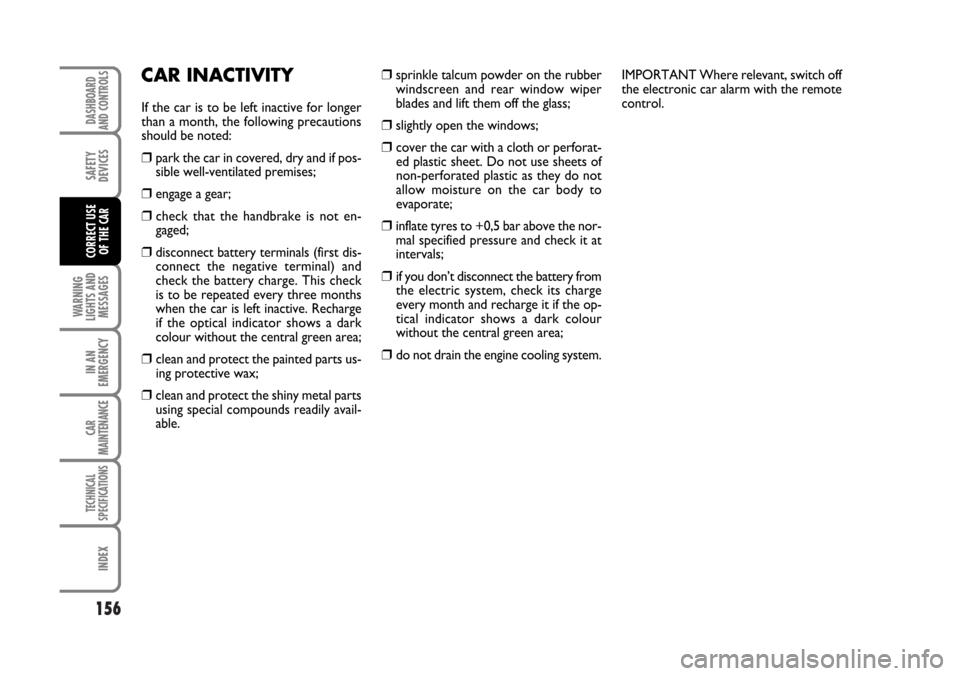
156
WARNING
LIGHTS AND
MESSAGES
IN AN
EMERGENCY
CAR
MAINTENANCE
TECHNICAL
SPECIFICATIONS
INDEX
DASHBOARD
AND CONTROLS
SAFETY
DEVICES
CORRECT USE
OF THE CAR
CAR INACTIVITY
If the car is to be left inactive for longer
than a month, the following precautions
should be noted:
❒park the car in covered, dry and if pos-
sible well-ventilated premises;
❒engage a gear;
❒ check that the handbrake is not en-
gaged;
❒disconnect battery terminals (first dis-
connect the negative terminal) and
check the battery charge. This check
is to be repeated every three months
when the car is left inactive. Recharge
if the optical indicator shows a dark
colour without the central green area;
❒ clean and protect the painted parts us-
ing protective wax;
❒clean and protect the shiny metal parts
using special compounds readily avail-
able.
❒sprinkle talcum powder on the rubber
windscreen and rear window wiper
blades and lift them off the glass;
❒slightly open the windows;
❒ cover the car with a cloth or perforat-
ed plastic sheet. Do not use sheets of
non-perforated plastic as they do not
allow moisture on the car body to
evaporate;
❒inflate tyres to +0,5 bar above the nor-
mal specified pressure and check it at
intervals;
❒ if you don’t disconnect the battery from
the electric system, check its charge
every month and recharge it if the op-
tical indicator shows a dark colour
without the central green area;
❒ do not drain the engine cooling system.IMPORTANT Where relevant, switch off
the electronic car alarm with the remote
control.
Page 158 of 274
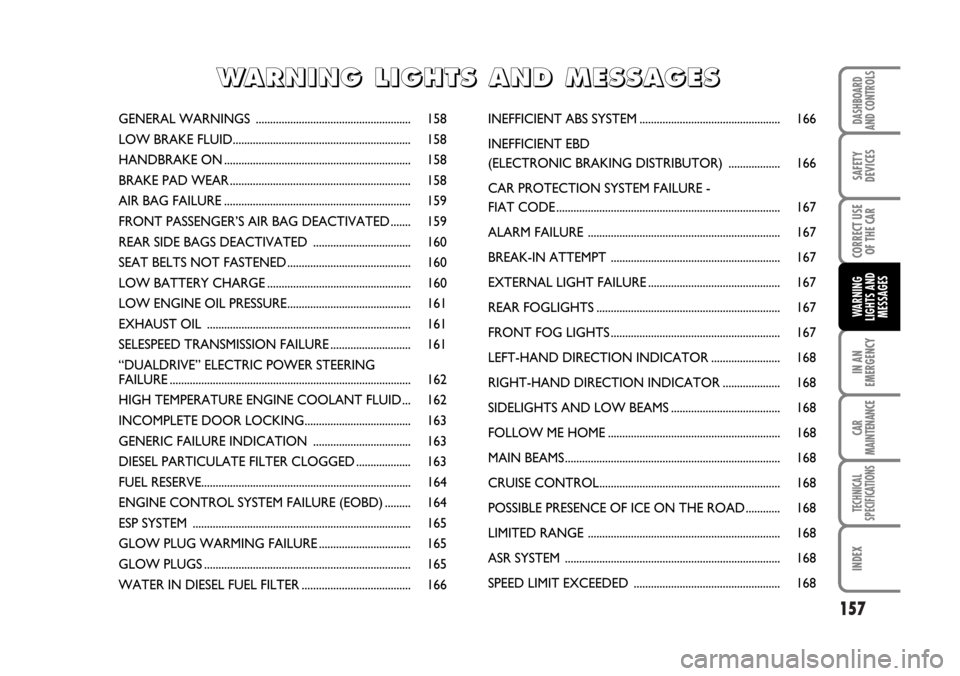
157
IN AN
EMERGENCY
CAR
MAINTENANCE
TECHNICAL
SPECIFICATIONS
INDEX
DASHBOARD
AND CONTROLS
SAFETY
DEVICES
CORRECT USE
OF THE CAR
WARNING
LIGHTS AND
MESSAGES
GENERAL WARNINGS ...................................................... 158
LOW BRAKE FLUID.............................................................. 158
HANDBRAKE ON ................................................................. 158
BRAKE PAD WEAR ............................................................... 158
AIR BAG FAILURE ................................................................. 159
FRONT PASSENGER’S AIR BAG DEACTIVATED ....... 159
REAR SIDE BAGS DEACTIVATED .................................. 160
SEAT BELTS NOT FASTENED ........................................... 160
LOW BATTERY CHARGE .................................................. 160
LOW ENGINE OIL PRESSURE........................................... 161
EXHAUST OIL ....................................................................... 161
SELESPEED TRANSMISSION FAILURE ............................ 161
“DUALDRIVE” ELECTRIC POWER STEERING
FAILURE .................................................................................... 162
HIGH TEMPERATURE ENGINE COOLANT FLUID ... 162
INCOMPLETE DOOR LOCKING..................................... 163
GENERIC FAILURE INDICATION .................................. 163
DIESEL PARTICULATE FILTER CLOGGED ................... 163
FUEL RESERVE......................................................................... 164
ENGINE CONTROL SYSTEM FAILURE (EOBD) ......... 164
ESP SYSTEM ............................................................................ 165
GLOW PLUG WARMING FAILURE ................................ 165
GLOW PLUGS ........................................................................ 165
WATER IN DIESEL FUEL FILTER ...................................... 166INEFFICIENT ABS SYSTEM ................................................. 166
INEFFICIENT EBD
(ELECTRONIC BRAKING DISTRIBUTOR) .................. 166
CAR PROTECTION SYSTEM FAILURE -
FIAT CODE .............................................................................. 167
ALARM FAILURE ................................................................... 167
BREAK-IN ATTEMPT ........................................................... 167
EXTERNAL LIGHT FAILURE .............................................. 167
REAR FOGLIGHTS ................................................................ 167
FRONT FOG LIGHTS ........................................................... 167
LEFT-HAND DIRECTION INDICATOR ........................ 168
RIGHT-HAND DIRECTION INDICATOR .................... 168
SIDELIGHTS AND LOW BEAMS ...................................... 168
FOLLOW ME HOME ............................................................ 168
MAIN BEAMS ........................................................................... 168
CRUISE CONTROL............................................................... 168
POSSIBLE PRESENCE OF ICE ON THE ROAD ............ 168
LIMITED RANGE ................................................................... 168
ASR SYSTEM ........................................................................... 168
SPEED LIMIT EXCEEDED ................................................... 168
W W
A A
R R
N N
I I
N N
G G
L L
I I
G G
H H
T T
S S
A A
N N
D D
M M
E E
S S
S S
A A
G G
E E
S S
Page 161 of 274
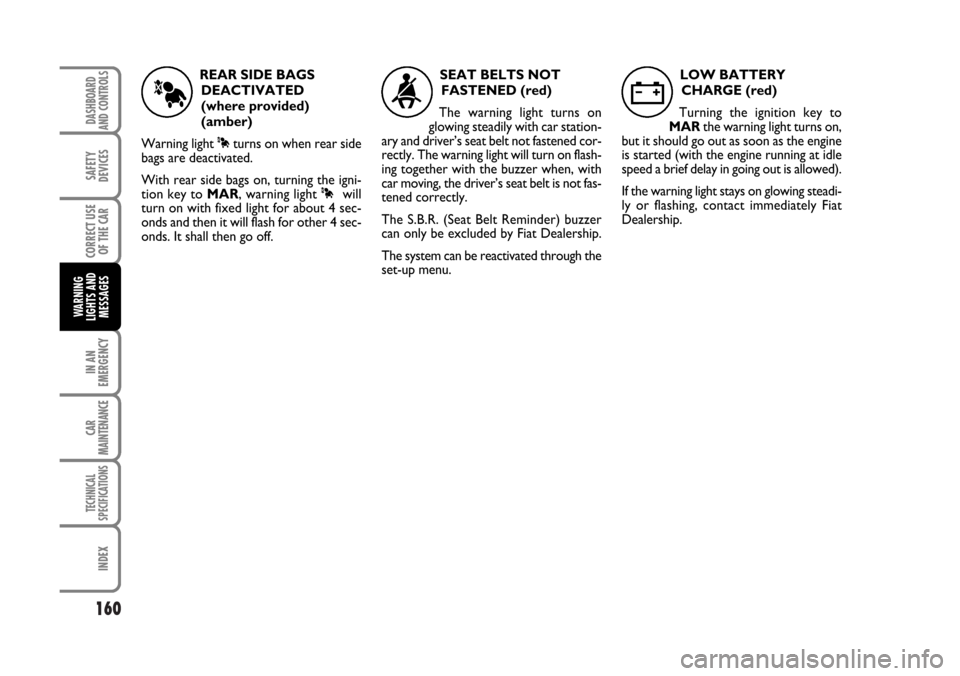
160
IN AN
EMERGENCY
CAR
MAINTENANCE
TECHNICAL
SPECIFICATIONS
INDEX
DASHBOARD
AND CONTROLS
SAFETY
DEVICES
CORRECT USE
OF THE CAR
WARNING
LIGHTS AND
MESSAGES
REAR SIDE BAGS
DEACTIVATED
(where provided)
(amber)
Warning light Àturns on when rear side
bags are deactivated.
With rear side bags on, turning the igni-
tion key to MAR, warning light Àwill
turn on with fixed light for about 4 sec-
onds and then it will flash for other 4 sec-
onds. It shall then go off.SEAT BELTS NOT
FASTENED (red)
The warning light turns on
glowing steadily with car station-
ary and driver’s seat belt not fastened cor-
rectly. The warning light will turn on flash-
ing together with the buzzer when, with
car moving, the driver’s seat belt is not fas-
tened correctly.
The S.B.R. (Seat Belt Reminder) buzzer
can only be excluded by Fiat Dealership.
The system can be reactivated through the
set-up menu.LOW BATTERY
CHARGE (red)
Turning the ignition key to
MARthe warning light turns on,
but it should go out as soon as the engine
is started (with the engine running at idle
speed a brief delay in going out is allowed).
If the warning light stays on glowing steadi-
ly or flashing, contact immediately Fiat
Dealership.
À
Page 162 of 274
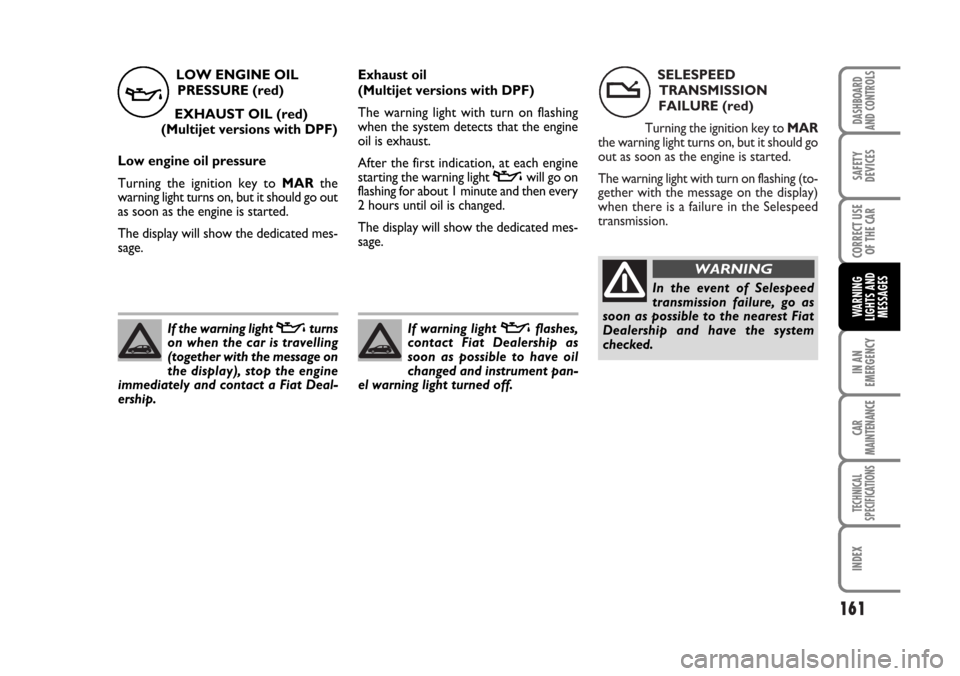
SELESPEED
TRANSMISSION
FAILURE (red)
Turning the ignition key to MAR
the warning light turns on, but it should go
out as soon as the engine is started.
The warning light with turn on flashing (to-
gether with the message on the display)
when there is a failure in the Selespeed
transmission.
t
161
IN AN
EMERGENCY
CAR
MAINTENANCE
TECHNICAL
SPECIFICATIONS
INDEX
DASHBOARD
AND CONTROLS
SAFETY
DEVICES
CORRECT USE
OF THE CAR
WARNING
LIGHTS AND
MESSAGES
LOW ENGINE OIL
PRESSURE (red)
EXHAUST OIL (red)
(Multijet versions with DPF)
Low engine oil pressure
Turning the ignition key to MARthe
warning light turns on, but it should go out
as soon as the engine is started.
The display will show the dedicated mes-
sage.
v
In the event of Selespeed
transmission failure, go as
soon as possible to the nearest Fiat
Dealership and have the system
checked.
WARNING
Exhaust oil
(Multijet versions with DPF)
The warning light with turn on flashing
when the system detects that the engine
oil is exhaust.
After the first indication, at each engine
starting the warning light vwill go on
flashing for about 1 minute and then every
2 hours until oil is changed.
The display will show the dedicated mes-
sage.
If the warning light vturns
on when the car is travelling
(together with the message on
the display), stop the engine
immediately and contact a Fiat Deal-
ership.
If warning light vflashes,
contact Fiat Dealership as
soon as possible to have oil
changed and instrument pan-
el warning light turned off.
Page 163 of 274
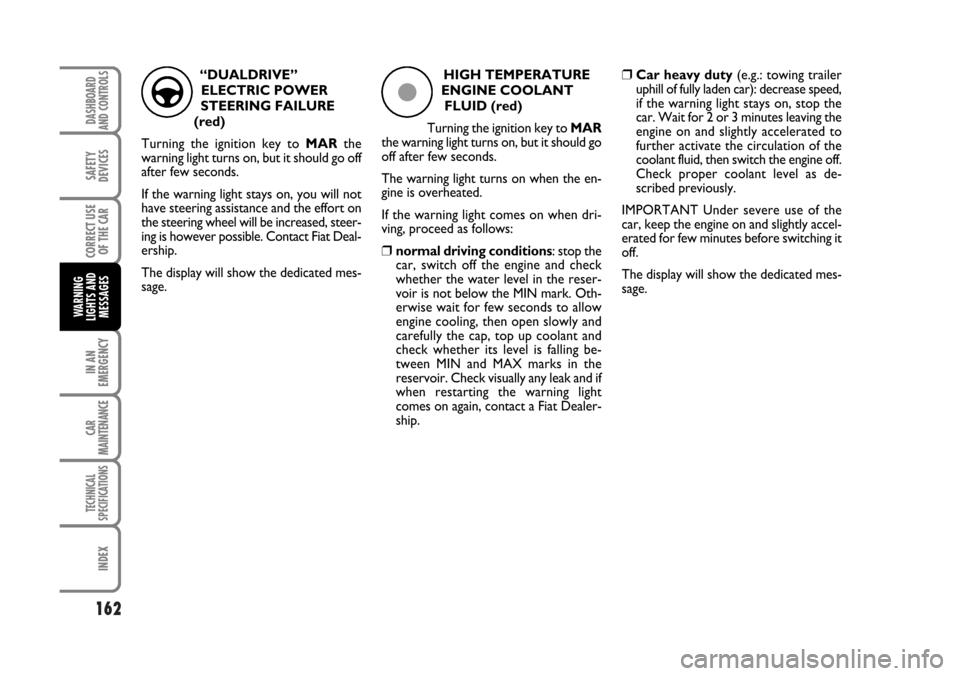
162
IN AN
EMERGENCY
CAR
MAINTENANCE
TECHNICAL
SPECIFICATIONS
INDEX
DASHBOARD
AND CONTROLS
SAFETY
DEVICES
CORRECT USE
OF THE CAR
WARNING
LIGHTS AND
MESSAGES
“DUALDRIVE”
ELECTRIC POWER
STEERING FAILURE
(red)
Turning the ignition key to MARthe
warning light turns on, but it should go off
after few seconds.
If the warning light stays on, you will not
have steering assistance and the effort on
the steering wheel will be increased, steer-
ing is however possible. Contact Fiat Deal-
ership.
The display will show the dedicated mes-
sage.HIGH TEMPERATURE
ENGINE COOLANT
FLUID (red)
Turning the ignition key to MAR
the warning light turns on, but it should go
off after few seconds.
The warning light turns on when the en-
gine is overheated.
If the warning light comes on when dri-
ving, proceed as follows:
❒normal driving conditions: stop the
car, switch off the engine and check
whether the water level in the reser-
voir is not below the MIN mark. Oth-
erwise wait for few seconds to allow
engine cooling, then open slowly and
carefully the cap, top up coolant and
check whether its level is falling be-
tween MIN and MAX marks in the
reservoir. Check visually any leak and if
when restarting the warning light
comes on again, contact a Fiat Dealer-
ship.
❒Car heavy duty(e.g.: towing trailer
uphill of fully laden car): decrease speed,
if the warning light stays on, stop the
car. Wait for 2 or 3 minutes leaving the
engine on and slightly accelerated to
further activate the circulation of the
coolant fluid, then switch the engine off.
Check proper coolant level as de-
scribed previously.
IMPORTANT Under severe use of the
car, keep the engine on and slightly accel-
erated for few minutes before switching it
off.
The display will show the dedicated mes-
sage.
gç